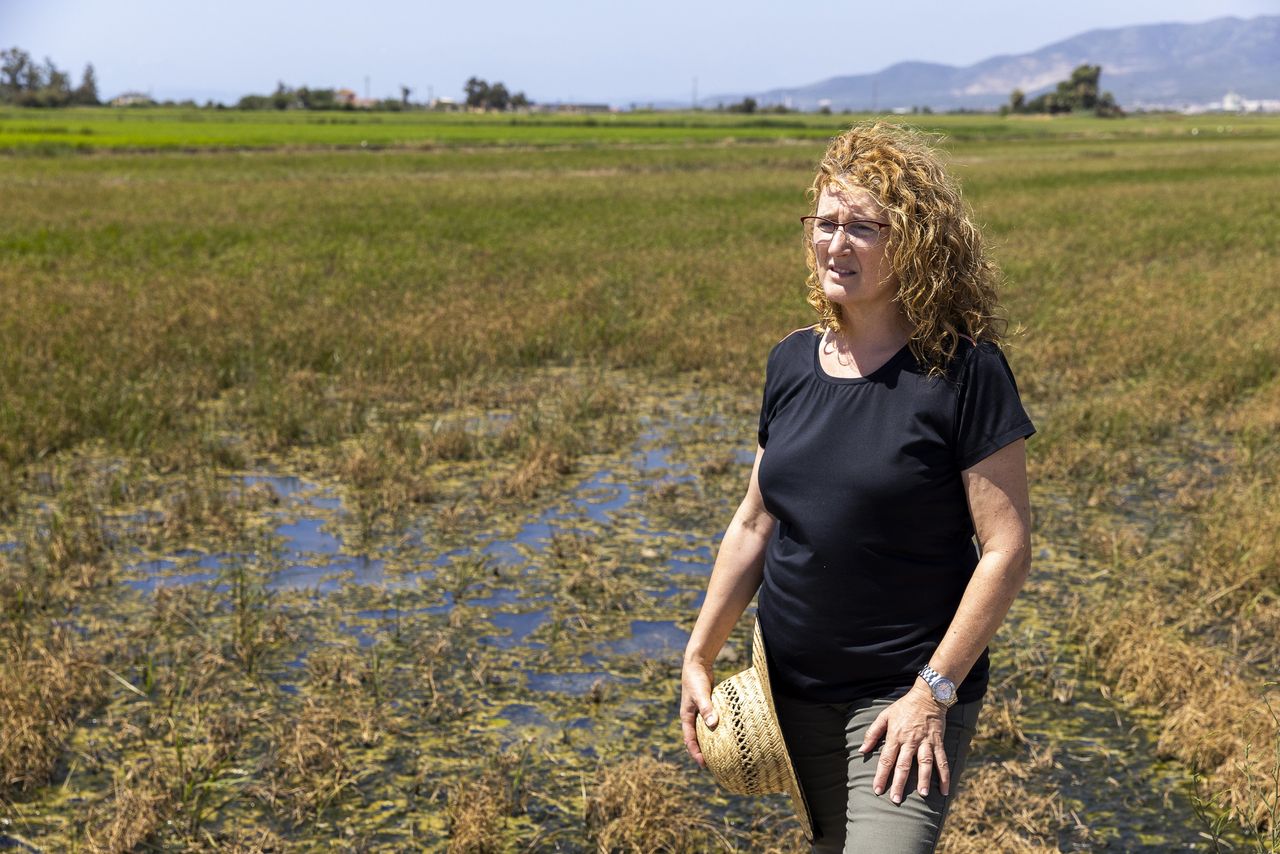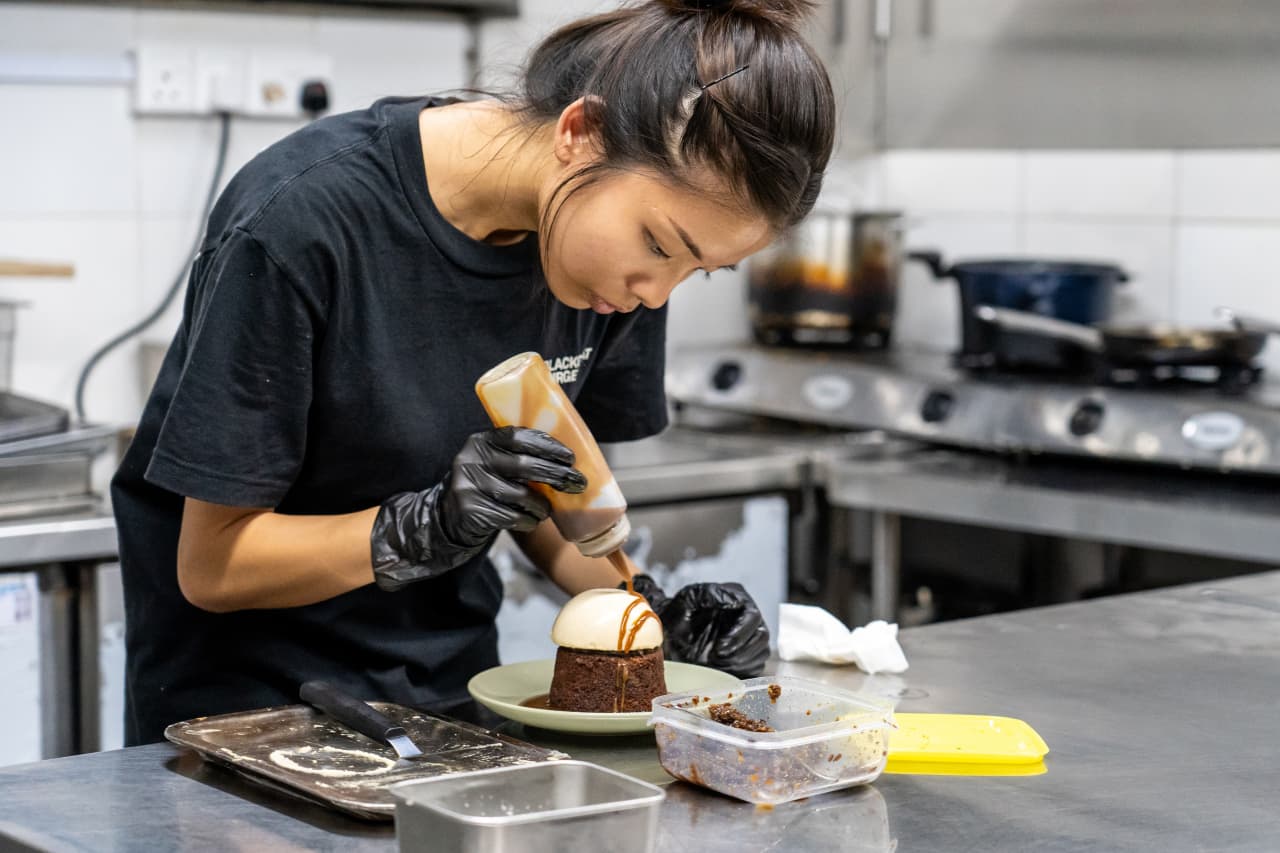It’s So Hot, They’re Growing Mangoes in Italy
Problems faced by farmers in the Mediterranean offer a preview into the challenges of feeding a warmer planet
EBRO DELTA, Spain—So much seawater is seeping into the paddy fields of this prized rice-growing region that Montserrat Sérvulo is considering replacing at least some of the crop with seaweed and clams.
“There is too much salt here,” said the 56-year-old farmer, standing on the edge of a field where she used to grow rice until last year. It is now filled with patchy grass and mud. “Last year wasn’t a good year, but at least we had something.”
Rising sea levels, dry spells and heat waves are disrupting food production in the Mediterranean, a region whose diet is regarded as a cultural treasure.
This year, prolonged drought and the scorching heat have hit agricultural production especially hard, wreaking havoc from the olive groves of Spain to the wheat fields of Algeria, reducing yields and pushing farmers to consider switching to hardier crops.
The recent heat wave has affected food production in other ways, too. Cows are producing less milk and bees are less willing to forage for pollen, with honey production down 70% compared with last year in Italy, according to Coldiretti, the country’s agricultural trade association.

The climate is changing faster in the Mediterranean than in most places on Earth. Average temperatures here have already risen by around 1.5 degrees Celsius since the dawn of the industrial age, more than in all other regions except the Arctic. The problems farmers face in the Mediterranean offer a preview into the challenges of feeding a hotter planet.
The Ebro Delta, where paddy fields are spread over some 20,000 hectares of land, is so vulnerable because it is coming under the twin pressures of rising sea levels and drought.
Seawater from the Mediterranean is reaching deeper inland than it used to, and there isn’t enough freshwater from the Ebro River to flush out the excess salt from the fields. Because of a prolonged drought, the river was running so dry this year that, for the first time ever, the water supply to the delta was interrupted for long stretches of time.
The result is what some farmers here say is shaping up as the worst harvest they have ever seen. “If we manage to harvest 30% of what we did last year, it will be a lot,” says Sérvulo, who grows rice varieties used to make beer, breakfast cereal and the local specialty, paella.
Short-term solutions include processing more wastewater and covering up canals to limit how much water evaporates. Creating buffer zones to counter coastal erosion, such as through artificial beaches, could also help. But that won’t solve the problem everywhere.
“In some areas, rice production isn’t feasible anymore,” says Carles Ibañez Martí, head of climate change at Eurecat, a Barcelona-based research centre, who has studied the Ebro Delta. “You can fight it to some extent, but adaptation has its limit and at some point you can’t adapt any more, you have to change.”
How close this turning point is depends on how fast the sea levels and temperatures rise. In the rice-producing areas of northern Italy the drought has been so acute this year that some farmers have already planted soybeans, which require less water, instead.
Scientists aren’t optimistic. The latest report by the United Nations Intergovernmental Panel on Climate Change says the effects of global warming in the Mediterranean Sea’s coastal countries are likely to intensify in the coming decades.
Scientists at IRTA, the Institute of Agrifood Research and Technology of Spain’s Catalonia region, are helping farmers adapt to climate change, including by studying fish, seaweed and clam varieties best suited to replace paddy fields in the wetlands of the Ebro Delta.
“We are developing the technology so that when there is need, we can easily transfer it. We need to have data from two-three years of production cycles to show [farmers] it’s a credible, feasible opportunity. If not, they will abandon these areas,” said Enric Gisbert, who oversees the aquaculture division of IRTA. “What is happening here will probably happen in other deltas of the Mediterranean.”
The IRTA has also developed a new breed of apple designed to withstand higher temperatures. Similar studies are happening elsewhere. In Israel, researchers recently developed a new variety of drought-proof tomato.
The drought is stressing the poorer southern rim of the Mediterranean, where economies are being forced to import more wheat and other food staples. In Algeria and Morocco, fields of wheat, barley and other staple crops along the country’s Mediterranean coast have turned yellow well before harvest time, dried out by a persistent lack of rainfall.
“There is no water. We can’t work,” said Mohammed Bahout, 80, whose family grows wheat and barley west of Algiers, in a region between the coast and the Algerian highlands that is the country’s bread basket. He used to grow tomatoes and other vegetables, but the lack of water forced him to grow less water-intensive staple crops instead.
“If the good Lord doesn’t send water, we’re finished,” Bahout said.
Some are trying to make the most of the changing climate. In southern Italy, farmers are growing tropical fruit such as mangoes.
The cultivation of fruits such as bananas, mangoes and avocados has increased threefold in Italy over the past five years, and now covers some 1,200 hectares of farmland in Italy’s southernmost regions of Sicily, Calabria and Puglia, according to Coldiretti.
In northern Italy, the warmer weather has enabled the large-scale production of tomatoes and olive oil—crops that until 15 years ago were a preserve of the peninsula’s central and southern regions.
“An increase in one or 1.5 degrees Celsius means we can now cultivate things such as wheat in northern Italy. But if the rise in temperature is followed by heavy rains and hailstorms with hails as big as tennis balls, that becomes a lot more complicated,” said Lorenzo Bazzana, who is in charge of economic analysis at Coldiretti. “Adapting to climate change isn’t so simple.”
In the Languedoc wine country in southern France, vineyards have been stifled by months of drought and now a heat wave. Lack of rain leaves grapes small and shrivelled, while heat can raise a wine’s alcohol content and dull the characteristic flavours of a terroir.
Languedoc, which stretches along the Mediterranean near Spain, is one of the French regions most at risk from rising heat and longer periods of drought.
“We have rarely seen a period this long without rain,” said Christophe Bousquet, president of Languedoc’s wine growers group. “The grapes aren’t very pretty. There are a lot of them, but they are extremely small.”
Languedoc wine growers are searching for ways to protect their livelihood from the growing impacts of climate change. Bousquet, who owns a vineyard in La Clape, a territory on the Mediterranean, is allowing the grass to grow around his vines to hold more moisture in the soil when it does rain.
They are also looking into planting different grape varieties that can better withstand drought and heat. That is a risky change, Bousquet said, and new vines take years to grow—time he says they don’t have.
“The problem is, time is against us,” he said. “The evolution of the climate in the Mediterranean is happening much faster than anticipated.”
—José Bautista contributed to this article
 Copyright 2020, Dow Jones & Company, Inc. All Rights Reserved Worldwide. LEARN MORE
Copyright 2020, Dow Jones & Company, Inc. All Rights Reserved Worldwide. LEARN MORE
This stylish family home combines a classic palette and finishes with a flexible floorplan
Just 55 minutes from Sydney, make this your creative getaway located in the majestic Hawkesbury region.
No trip to Singapore is complete without a meal (or 12) at its hawker centres, where stalls sell multicultural dishes from generations-old recipes. But rising costs and demographic change are threatening the beloved tradition.
In Singapore, it’s not unusual for total strangers to ask, “Have you eaten yet?” A greeting akin to “Good morning,” it invariably leads to follow-up questions. What did you eat? Where did you eat it? Was it good? Greeters reserve the right to judge your responses and offer advice, solicited or otherwise, on where you should eat next.
Locals will often joke that gastronomic opinions can make (and break) relationships and that eating is a national pastime. And why wouldn’t it be? In a nexus of colliding cultures—a place where Malays, Indians, Chinese and Europeans have brushed shoulders and shared meals for centuries—the mix of flavours coming out of kitchens in this country is enough to make you believe in world peace.
While Michelin stars spangle Singapore’s restaurant scene , to truly understand the city’s relationship with food, you have to venture to the hawker centres. A core aspect of daily life, hawker centres sprang up in numbers during the 1970s, built by authorities looking to sanitise and formalise the city’s street-food scene. Today, 121 government-run hawker centres feature food stalls that specialise in dishes from the country’s various ethnic groups. In one of the world’s most expensive cities, hawker dishes are shockingly cheap: A full meal can cost as little as $3.
Over the course of many visits to Singapore, I’ve fallen in love with these places—and with the scavenger hunts to find meals I’ll never forget: delicate bowls of laksa noodle soup, where brisk lashes of heat interrupt addictive swirls of umami; impossibly flaky roti prata dipped in curry; the beautiful simplicity of an immaculately roasted duck leg. In a futuristic and at times sterile city, hawker centres throw back to the past and offer a rare glimpse of something human in scale. To an outsider like me, sitting at a table amid the din of the lunch-hour rush can feel like glimpsing the city’s soul through all the concrete and glitz.
So I’ve been alarmed in recent years to hear about the supposed demise of hawker centres. Would-be hawkers have to bid for stalls from the government, and rents are climbing . An upwardly mobile generation doesn’t want to take over from their parents. On a recent trip to Singapore, I enlisted my brother, who lives there, and as we ate our way across the city, we searched for signs of life—and hopefully a peek into what the future holds.
At Amoy Street Food Centre, near the central business district, 32-year-old Kai Jin Thng has done the math. To turn a profit at his stall, Jin’s Noodle , he says, he has to churn out at least 150 $4 bowls of kolo mee , a Malaysian dish featuring savoury pork over a bed of springy noodles, in 120 minutes of lunch service. With his sister as sous-chef, he slings the bowls with frenetic focus.
Thng dropped out of school as a teenager to work in his father’s stall selling wonton mee , a staple noodle dish, and is quick to say no when I ask if he wants his daughter to take over the stall one day.
“The tradition is fading and I believe that in the next 10 or 15 years, it’s only going to get worse,” Thng said. “The new generation prefers to put on their tie and their white collar—nobody really wants to get their hands dirty.”
In 2020, the National Environment Agency , which oversees hawker centres, put the median age of hawkers at 60. When I did encounter younger people like Thng in the trade, I found they persevered out of stubbornness, a desire to innovate on a deep-seated tradition—or some combination of both.
Later that afternoon, looking for a momentary reprieve from Singapore’s crushing humidity, we ducked into Market Street Hawker Centre and bought juice made from fresh calamansi, a small citrus fruit.
Jamilah Beevi, 29, was working the shop with her father, who, at 64, has been a hawker since he was 12. “I originally stepped in out of filial duty,” she said. “But I find it to be really fulfilling work…I see it as a generational shop, so I don’t want to let that die.” When I asked her father when he’d retire, he confidently said he’d hang up his apron next year. “He’s been saying that for many years,” Beevi said, laughing.
More than one Singaporean told me that to truly appreciate what’s at stake in the hawker tradition’s threatened collapse, I’d need to leave the neighbourhoods where most tourists spend their time, and venture to the Heartland, the residential communities outside the central business district. There, hawker centres, often combined with markets, are strategically located near dense housing developments, where they cater to the 77% of Singaporeans who live in government-subsidised apartments.
We ate laksa from a stall at Ghim Moh Market and Food Centre, where families enjoyed their Sunday. At Redhill Food Centre, a similar chorus of chattering voices and clattering cutlery filled the space, as diners lined up for prawn noodles and chicken rice. Near our table, a couple hungrily unwrapped a package of durian, a coveted fruit banned from public transportation and some hotels for its strong aroma. It all seemed like business as usual.
Then we went to Blackgoat . Tucked in a corner of the Jalan Batu housing development, Blackgoat doesn’t look like an average hawker operation. An unusually large staff of six swirled around a stall where Fikri Amin Bin Rohaimi, 24, presided over a fiery grill and a seriously ambitious menu. A veteran of the three-Michelin-star Zén , Rohaimi started selling burgers from his apartment kitchen in 2019, before opening a hawker stall last year. We ordered everything on the menu and enjoyed a feast that would astound had it come out of a fully equipped restaurant kitchen; that it was all made in a 130-square-foot space seemed miraculous.
Mussels swam in a mushroom broth, spiked with Thai basil and chives. Huge, tender tiger prawns were grilled to perfection and smothered in toasted garlic and olive oil. Lamb was coated in a whisper of Sichuan peppercorns; Wagyu beef, in a homemade makrut-lime sauce. Then Ethel Yam, Blackgoat’s pastry chef prepared a date pudding with a mushroom semifreddo and a panna cotta drizzled in chamomile syrup. A group of elderly residents from the nearby towers watched, while sipping tiny glasses of Tiger beer.
Since opening his stall, Rohaimi told me, he’s seen his food referred to as “restaurant-level hawker food,” a categorisation he rejects, feeling it discounts what’s possible at a hawker centre. “If you eat hawker food, you know that it can often be much better than anything at a restaurant.”
He wants to open a restaurant eventually—or, leveraging his in-progress biomedical engineering degree, a food lab. But he sees the modern hawker centre not just as a steppingstone, but a place to experiment. “Because you only have to manage so many things, unlike at a restaurant, a hawker stall right now gives us a kind of limitlessness to try new things,” he said.
Using high-grade Australian beef and employing a whole staff, Rohaimi must charge more than typical hawker stalls, though his food, around $12 per 100 grams of steak, still costs far less than high-end restaurant fare. He’s found that people will pay for quality, he says, even if he first has to convince them to try the food.
At Yishun Park Hawker Centre (now temporarily closed for renovations), Nurl Asyraffie, 33, has encountered a similar dynamic since he started Kerabu by Arang , a stall specialising in “modern Malay food.” The day we came, he was selling ayam percik , a grilled chicken leg smothered in a bewitching turmeric-based marinade. As we ate, a hawker from another stall came over to inquire how much we’d paid. When we said around $10 a plate, she looked skeptical: “At least it’s a lot of food.”
Asyraffie, who opened the stall after a spell in private dining and at big-name restaurants in the region, says he’s used to dubious reactions. “I think the way you get people’s trust is you need to deliver,” he said. “Singapore is a melting pot; we’re used to trying new things, and we will pay for food we think is worth it.” He says a lot of the same older “uncles” who gawked at his prices, are now regulars. “New hawkers like me can fill a gap in the market, slightly higher than your chicken rice, but lower than a restaurant.”
But economics is only half the battle for a new generation of hawkers, says Seng Wun Song, a 64-year-old, semiretired economist who delves into the inner workings of Singapore’s food-and-beverage industry as a hobby. He thinks locals and tourists who come to hawker centers to look for “authentic” Singaporean food need to rethink what that amorphous catchall word really means. What people consider “heritage food,” he explains, is a mix of Malay, Chinese, Indian and European dishes that emerged from the country’s founding. “But Singapore is a trading hub where people come and go, and heritage moves and changes. Hawker food isn’t dying; it’s evolving so that it doesn’t die.”
This stylish family home combines a classic palette and finishes with a flexible floorplan
Just 55 minutes from Sydney, make this your creative getaway located in the majestic Hawkesbury region.






















